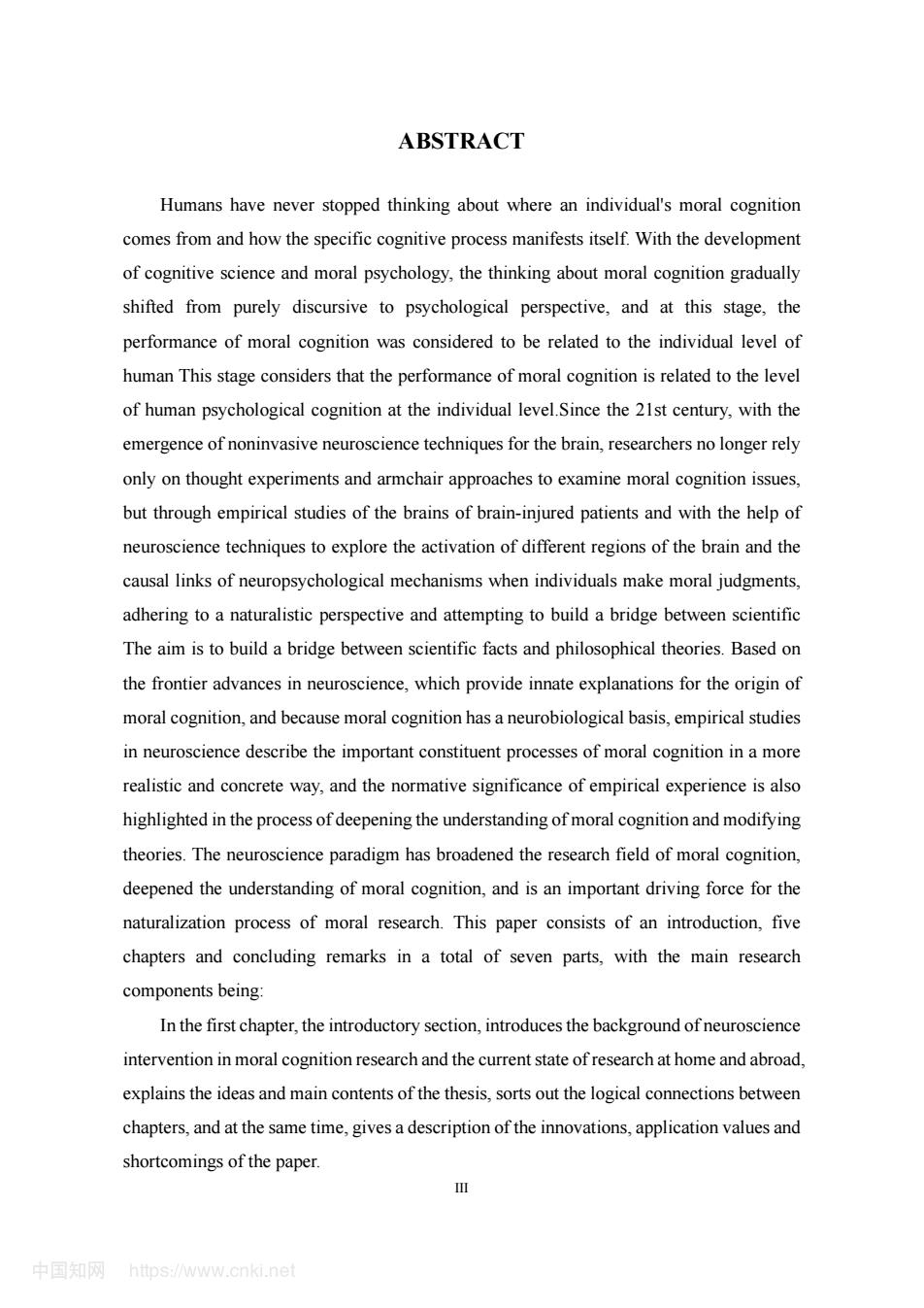
ABSTRACT Humans have never stopped thinking about where an individual's moral cognition comes from and how the specific cognitive process manifests itself.With the development of cognitive science and moral psychology,the thinking about moral cognition gradually shifted from purely discursive to psychological perspective,and at this stage,the performance of moral cognition was considered to be related to the individual level of human This stage considers that the performance of moral cognition is related to the level of human psychological cognition at the individual level.Since the 21st century,with the emergence of noninvasive neuroscience techniques for the brain,researchers no longer rely only on thought experiments and armchair approaches to examine moral cognition issues, but through empirical studies of the brains of brain-injured patients and with the help of neuroscience techniques to explore the activation of different regions of the brain and the causal links of neuropsychological mechanisms when individuals make moral judgments. adhering to a naturalistic perspective and attempting to build a bridge between scientific The aim is to build a bridge between scientific facts and philosophical theories.Based on the frontier advances in neuroscience,which provide innate explanations for the origin of moral cognition,and because moral cognition has a neurobiological basis,empirical studie in neuroscience describe the important constituent processes of moral cognition in a more realistic and concrete way,and the normative significance of empirical experience is also highlighted in the process of deepening the understanding of moral cognition and modifying theories.The neuroscience paradigm has broadened the research field of moral cognition, deepened the understanding of moral cognition,and is an important driving force for the naturalization process of moral research.This paper consists of an introduction,five chapters and concluding remarks in a total of seven parts,with the main research components being: In the first chapter,the introductory section,introduces the background of neuroscience intervention in moral cognition research and the current state of research at home and abroad explains the ideas and main contents of the thesis,sorts out the logical connections between chapters,and at the same time,gives a description of the innovations,application values and shortcomings of the paper
III ABSTRACT Humans have never stopped thinking about where an individual's moral cognition comes from and how the specific cognitive process manifests itself. With the development of cognitive science and moral psychology, the thinking about moral cognition gradually shifted from purely discursive to psychological perspective, and at this stage, the performance of moral cognition was considered to be related to the individual level of human This stage considers that the performance of moral cognition is related to the level of human psychological cognition at the individual level.Since the 21st century, with the emergence of noninvasive neuroscience techniques for the brain, researchers no longer rely only on thought experiments and armchair approaches to examine moral cognition issues, but through empirical studies of the brains of brain-injured patients and with the help of neuroscience techniques to explore the activation of different regions of the brain and the causal links of neuropsychological mechanisms when individuals make moral judgments, adhering to a naturalistic perspective and attempting to build a bridge between scientific The aim is to build a bridge between scientific facts and philosophical theories. Based on the frontier advances in neuroscience, which provide innate explanations for the origin of moral cognition, and because moral cognition has a neurobiological basis, empirical studies in neuroscience describe the important constituent processes of moral cognition in a more realistic and concrete way, and the normative significance of empirical experience is also highlighted in the process of deepening the understanding of moral cognition and modifying theories. The neuroscience paradigm has broadened the research field of moral cognition, deepened the understanding of moral cognition, and is an important driving force for the naturalization process of moral research. This paper consists of an introduction, five chapters and concluding remarks in a total of seven parts, with the main research components being: In the first chapter, the introductory section, introduces the background of neuroscience intervention in moral cognition research and the current state of research at home and abroad, explains the ideas and main contents of the thesis, sorts out the logical connections between chapters, and at the same time, gives a description of the innovations, application values and shortcomings of the paper
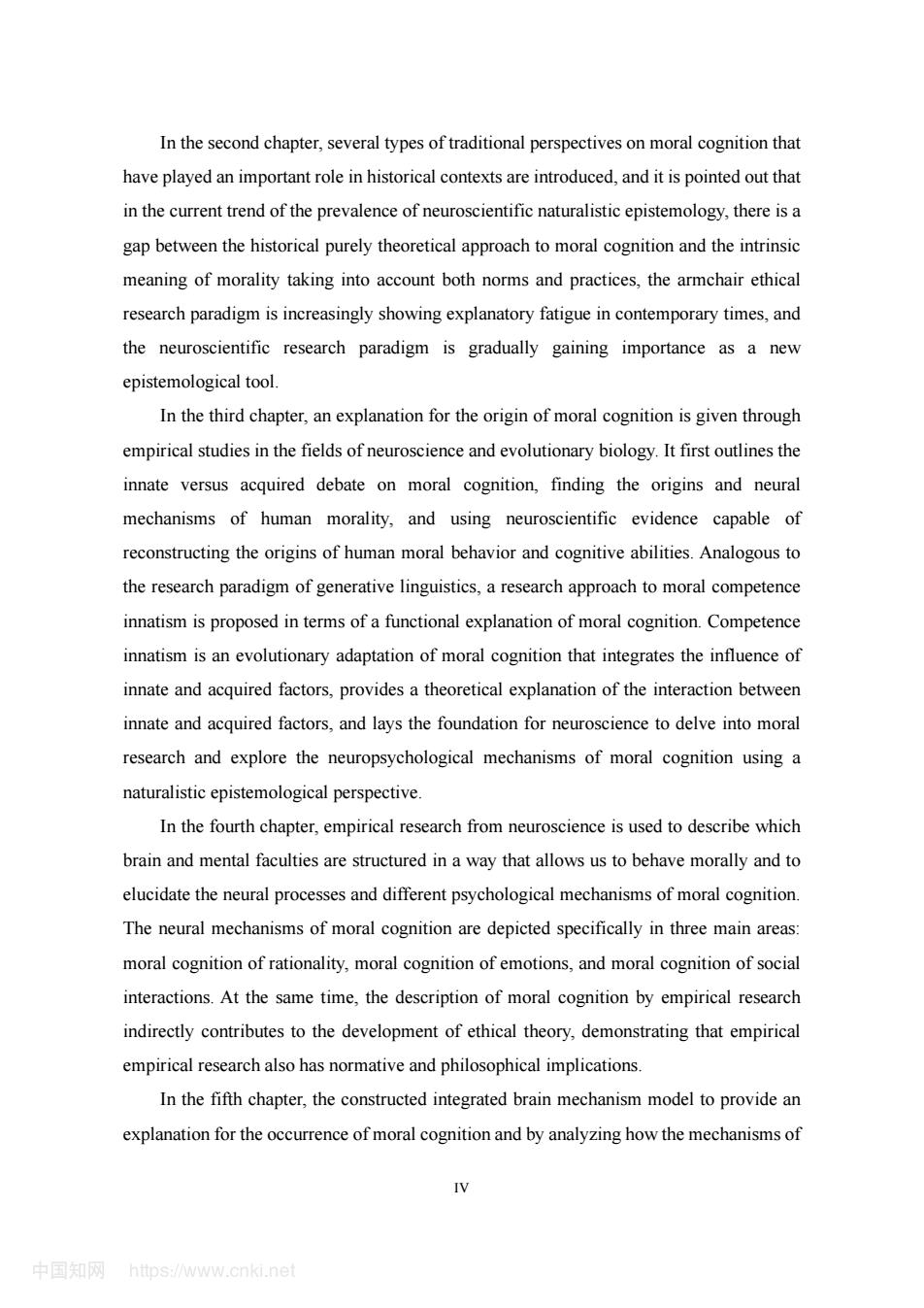
In the second chapter,several types of traditional perspectives on moral cognition that have played an important role in historical contexts are introduced,and it is pointed out that in the current trend of the prevalence of neuroscientific naturalistic epistemology,there is a gap between the historical purely theoretical approach to moral cognition and the intrinsic meaning of morality taking into account both norms and practices,the armchair ethical research paradigm is increasingly showing explanatory fatigue in contemporary times,and the neuroscientific research paradigm is gradually gaining importance as a new epistemological tool. In the third chapter,an explanation for the origin of moral cognition is given through empirical studies in the fields of neuroscience and evolutionary biology.It first outlines the innate versus acquired debate on moral cognition,finding the origins and neural mechanisms of human morality,and using neuroscientific evidence capable of reconstructing the origins of human moral behavior and cognitive abilities.Analogous to the research paradigm of generative linguistics,a research approach to moral competence innatism is proposed in terms of a functional explanation of moral cognition.Competence innatism is an evolutionary adaptation of moral cognition that integrates the influence of innate and acquired factors,provides a theoretical explanation of the interaction between innate and acquired factors,and lays the foundation for neuroscience to delve into moral research and explore the neuropsychological mechanisms of moral cognition using a naturalistic epistemological perspective In the fourth chapter,empirical research from neuroscience is used to describe which brain and mental faculties are structured in a way that allows us to behave morally and to elucidate the neural processes and different psychological mechanisms of moral cognition The neural mechanisms of moral cognition are depicted specifically in three main areas moral cognition of rationality,moral cognition of emotions,and moral cognition of social interactions.At the same time,the description of moral cognition by empirical research indirectly contributes to the development of ethical theory,demonstrating that empirical empirical research also has normative and philosophical implications. In the fifth chapter,the constructed integrated brain mechanism model to provide an explanation for the occurrence of moral cognition and by analyzing how the mechanisms of 中国知网https://www.cnk.ne
IV In the second chapter, several types of traditional perspectives on moral cognition that have played an important role in historical contexts are introduced, and it is pointed out that in the current trend of the prevalence of neuroscientific naturalistic epistemology, there is a gap between the historical purely theoretical approach to moral cognition and the intrinsic meaning of morality taking into account both norms and practices, the armchair ethical research paradigm is increasingly showing explanatory fatigue in contemporary times, and the neuroscientific research paradigm is gradually gaining importance as a new epistemological tool. In the third chapter, an explanation for the origin of moral cognition is given through empirical studies in the fields of neuroscience and evolutionary biology. It first outlines the innate versus acquired debate on moral cognition, finding the origins and neural mechanisms of human morality, and using neuroscientific evidence capable of reconstructing the origins of human moral behavior and cognitive abilities. Analogous to the research paradigm of generative linguistics, a research approach to moral competence innatism is proposed in terms of a functional explanation of moral cognition. Competence innatism is an evolutionary adaptation of moral cognition that integrates the influence of innate and acquired factors, provides a theoretical explanation of the interaction between innate and acquired factors, and lays the foundation for neuroscience to delve into moral research and explore the neuropsychological mechanisms of moral cognition using a naturalistic epistemological perspective. In the fourth chapter, empirical research from neuroscience is used to describe which brain and mental faculties are structured in a way that allows us to behave morally and to elucidate the neural processes and different psychological mechanisms of moral cognition. The neural mechanisms of moral cognition are depicted specifically in three main areas: moral cognition of rationality, moral cognition of emotions, and moral cognition of social interactions. At the same time, the description of moral cognition by empirical research indirectly contributes to the development of ethical theory, demonstrating that empirical empirical research also has normative and philosophical implications. In the fifth chapter, the constructed integrated brain mechanism model to provide an explanation for the occurrence of moral cognition and by analyzing how the mechanisms of
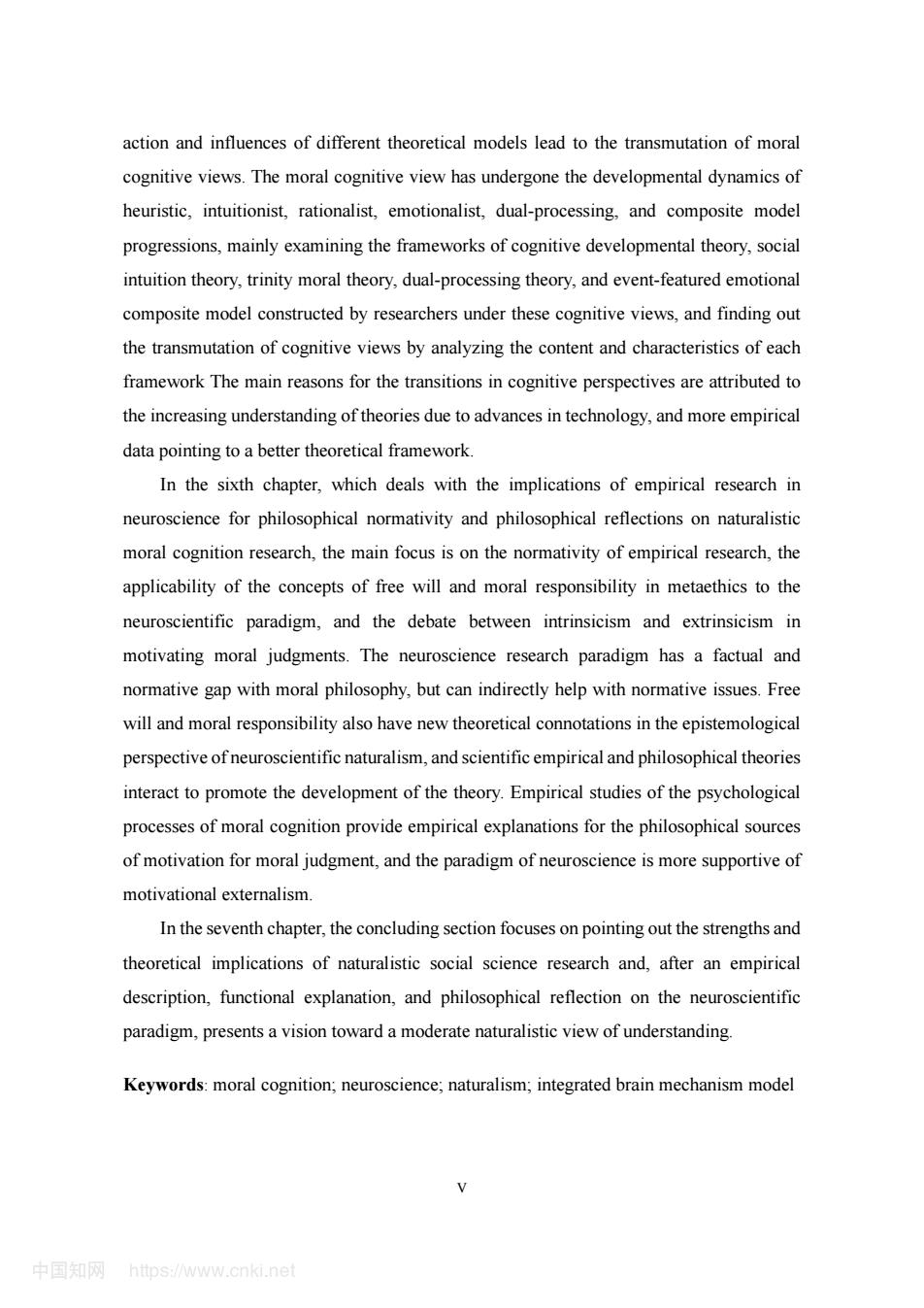
action and influences of different theoretical models lead to the transmutation of moral cognitive views.The moral cognitive view has undergone the developmental dynamics of heuristic,intuitionist,rationalist,emotionalist,dual-processing.and composite model progressions,mainly examining the frameworks of cognitive developmental theory,social intuition theory,trinity moral theory,dual-processing theory,and event-featured emotional composite model constructed by researchers under these cognitive views,and finding out the transmutation of cognitive views by analyzing the content and characteristics of each framework The main reasons for the transitions in cognitive perspectives are attributed to the increasing understanding of theories due to advances in technology,and more empirical data pointing to a better theoretical framework In the sixth chapter,which deals with the implications of empirical research in neuroscience for philosophical normativity and philosophical reflections on naturalistic moral cognition research,the main focus is on the normativity of empirical research,the applicability of the concepts of free will and moral responsibility in metaethics to the neuroscientific paradigm,and the debate between intrinsicism and extrinsicism in motivating moral judgments.The neuroscience research paradigm has a factual and normative gap with moral philosophy.but can indirectly help with normative issues.Free will and moral responsibility also have new theoretical connotations in the epistemological perspective of neuroscientific naturalismand scientificempirical and philosophical theories interact to promote the development of the theory.Empirical studies of the psychological processes of moral cognition provide empirical explanations for the philosophical sources of motivation for moral judgment,and the paradigm of neuroscience is more supportive of motivational externalism In the seventh chapter,the concluding section focuses on pointing out the strengths and theoretical implications of naturalistic social science research and,after an empirical description,functional explanation,and philosophical reflection on the neuroscientific paradigm,presents a vision toward a moderate naturalistic view of understanding. Keywords:moral cognition;neuroscience;naturalism;integrated brain mechanism model
V action and influences of different theoretical models lead to the transmutation of moral cognitive views. The moral cognitive view has undergone the developmental dynamics of heuristic, intuitionist, rationalist, emotionalist, dual-processing, and composite model progressions, mainly examining the frameworks of cognitive developmental theory, social intuition theory, trinity moral theory, dual-processing theory, and event-featured emotional composite model constructed by researchers under these cognitive views, and finding out the transmutation of cognitive views by analyzing the content and characteristics of each framework The main reasons for the transitions in cognitive perspectives are attributed to the increasing understanding of theories due to advances in technology, and more empirical data pointing to a better theoretical framework. In the sixth chapter, which deals with the implications of empirical research in neuroscience for philosophical normativity and philosophical reflections on naturalistic moral cognition research, the main focus is on the normativity of empirical research, the applicability of the concepts of free will and moral responsibility in metaethics to the neuroscientific paradigm, and the debate between intrinsicism and extrinsicism in motivating moral judgments. The neuroscience research paradigm has a factual and normative gap with moral philosophy, but can indirectly help with normative issues. Free will and moral responsibility also have new theoretical connotations in the epistemological perspective of neuroscientific naturalism, and scientific empirical and philosophical theories interact to promote the development of the theory. Empirical studies of the psychological processes of moral cognition provide empirical explanations for the philosophical sources of motivation for moral judgment, and the paradigm of neuroscience is more supportive of motivational externalism. In the seventh chapter, the concluding section focuses on pointing out the strengths and theoretical implications of naturalistic social science research and, after an empirical description, functional explanation, and philosophical reflection on the neuroscientific paradigm, presents a vision toward a moderate naturalistic view of understanding. Keywords: moral cognition; neuroscience; naturalism; integrated brain mechanism model
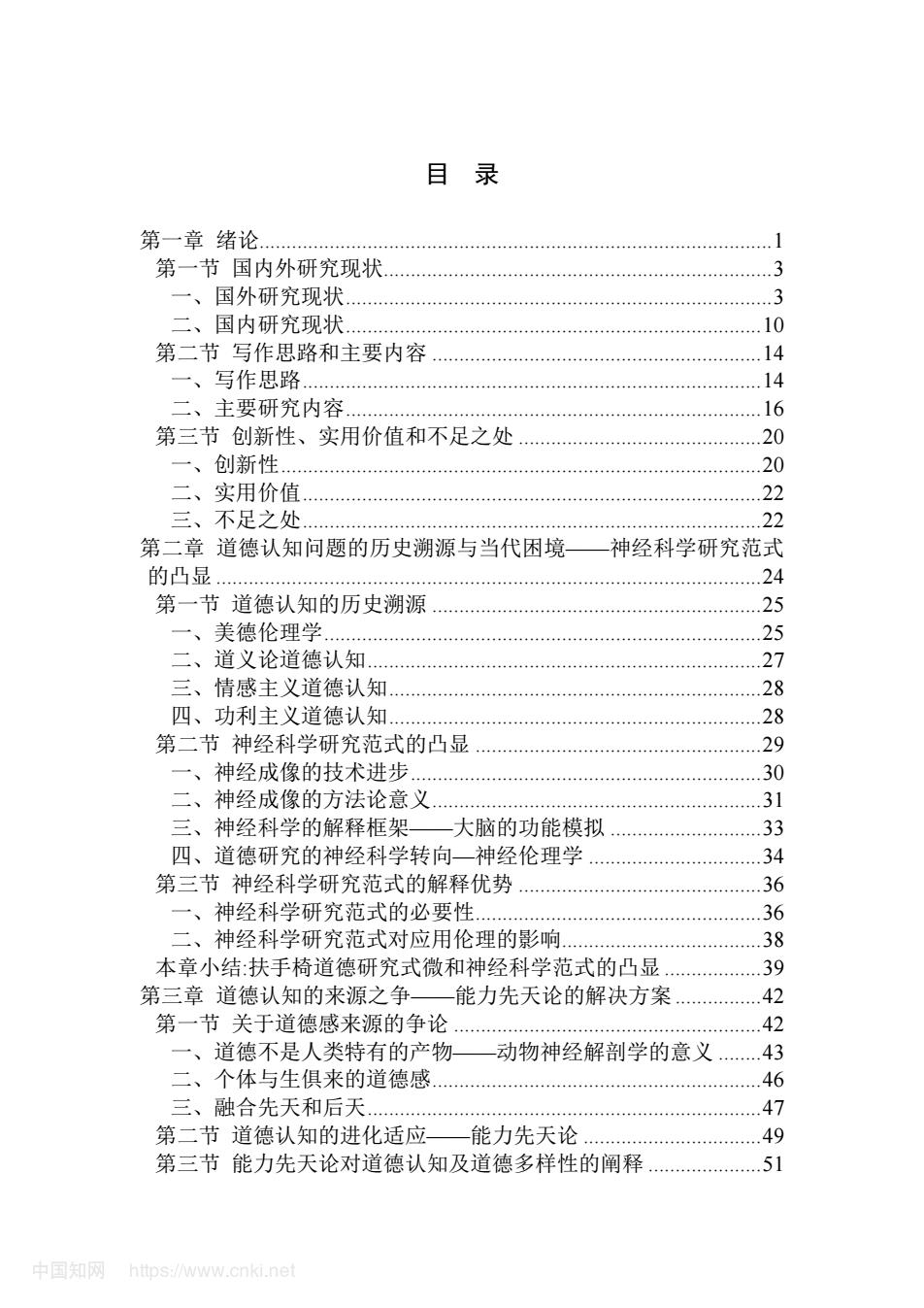
目录 第一章绪论 第一节国内外研究现状 一、国外研究现状 二、国内研究现状 10 第二节写作思路和主要内容 一、写作思路 14 二、主要研究内容 16 第三节创新性、实用价值和不足之处 20 一、创新性 20 二、实用价值 三、不足之处 .22 第二章道德认知问题的历史溯源与当代困境 神经科学研究范式 的马品 24 第一节道德认知的历史溯源 25 一、美德伦理学 25 二、 道义论道德认知 27 三、情感主义道德认知 .28 四、功利主义道德认知 28 第二节神经科学研究范式的凸显 29 一、 神经成像的技术进步 .30 二、 神经成像的方法论意义 31 、 神经科学的解释框架 大脑的功能模拟 ,33 四、道德研究的神经科学转向一神经伦理学 34 第三节神经科学研究范式的解释优势 6 一、神经学研究节式的以要件 36 神经科学研究范式对应用伦理的影响 8 本章小结:扶手椅道德研究式微和神经科学范式的凸显 39 第三章道德认知的来源之争 能力先天论的解决方案 .42 第一节关于道德感来源的争论 42 道德不是人类特有的产物 动物神经解剖学的意义.43 二、个体与生俱来的道德感 46 三、融合先天和后天 .47 第二节道德认知的进化适应 能力先天金 .49 第三节能力先天论对道德认知及道德多样性的阐释, 51 中国知网 www.cnki.ne
目 录 第一章 绪论.1 第一节 国内外研究现状.3 一、国外研究现状.3 二、国内研究现状.10 第二节 写作思路和主要内容 .14 一、写作思路.14 二、主要研究内容.16 第三节 创新性、实用价值和不足之处 .20 一、创新性.20 二、实用价值.22 三、不足之处.22 第二章 道德认知问题的历史溯源与当代困境——神经科学研究范式 的凸显.24 第一节 道德认知的历史溯源 .25 一、美德伦理学.25 二、道义论道德认知.27 三、情感主义道德认知.28 四、功利主义道德认知.28 第二节 神经科学研究范式的凸显 .29 一、神经成像的技术进步.30 二、神经成像的方法论意义.31 三、神经科学的解释框架——大脑的功能模拟 .33 四、道德研究的神经科学转向—神经伦理学 .34 第三节 神经科学研究范式的解释优势 .36 一、神经科学研究范式的必要性.36 二、神经科学研究范式对应用伦理的影响.38 本章小结:扶手椅道德研究式微和神经科学范式的凸显 .39 第三章 道德认知的来源之争——能力先天论的解决方案.42 第一节 关于道德感来源的争论 .42 一、道德不是人类特有的产物——动物神经解剖学的意义 .43 二、个体与生俱来的道德感.46 三、融合先天和后天.47 第二节 道德认知的进化适应——能力先天论 .49 第三节 能力先天论对道德认知及道德多样性的阐释 .51
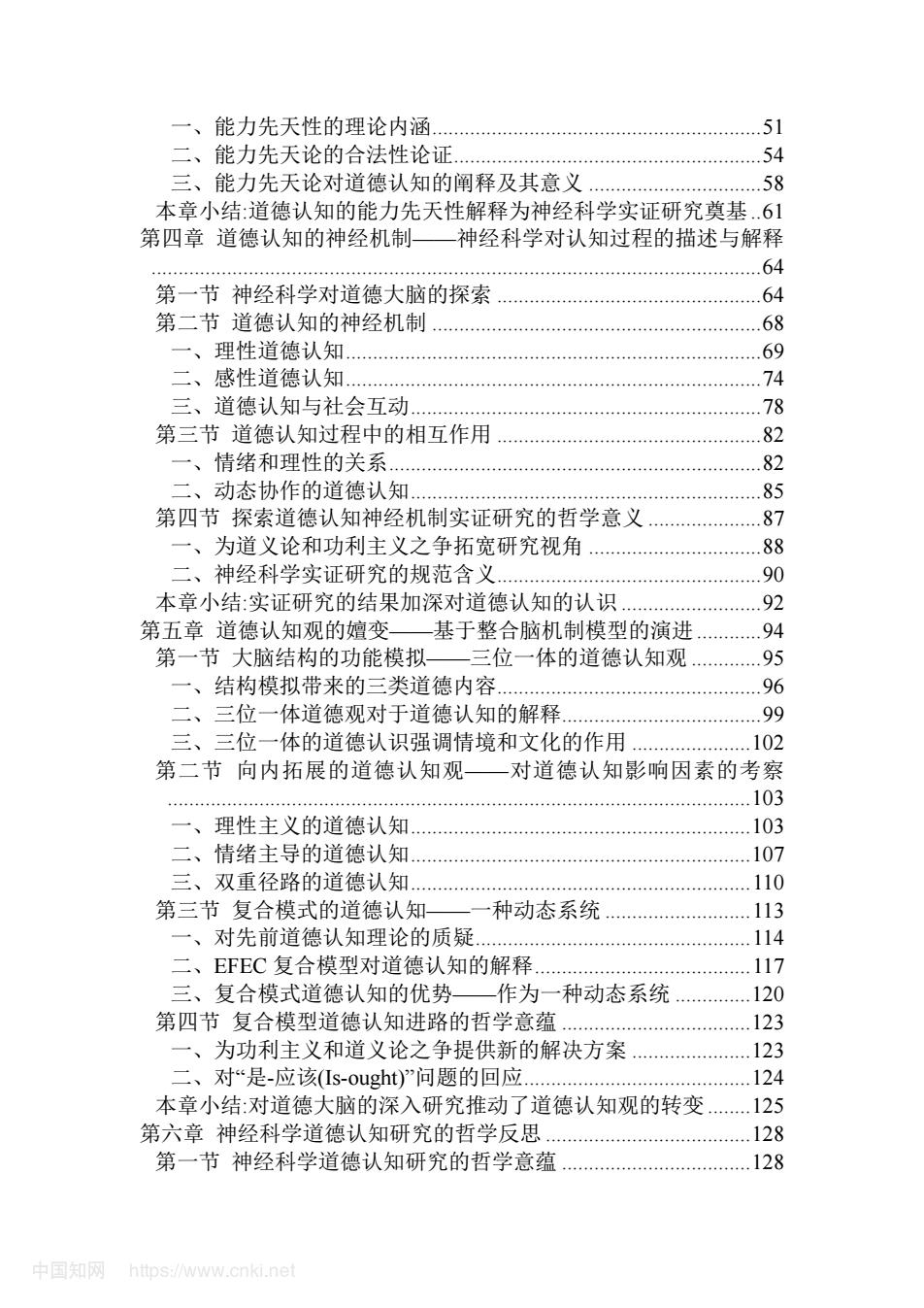
一、能力先天性的理论内涵 二、能力先天论的合法性论证 .54 三、能力先天论对道德认知的阐释及其意义 58 本章小结:道德认知的能力先天性解释为神经科学实证研究奠基.61 第四章道德认知的神经机制 神经科学对认知过程的描述与解释 64 第一节神经科学对道德大脑的探索 64 第二节道德认知的神经机制 68 一、 理性道德认知 69 二、感性道德认知 74 三、道德认知与社会互动 78 第三节道德认知过程中的相互作用 .82 一、情绪和理性的关系 82 二、动态协作的道德认知 .85 第四节探索道德认知神经机制实证研究的哲学意义 .87 一、为道义论和功利主义之争拓宽研究视角】 88 、神经科学实证研究的规范含义 0 本章小结:实证研究的结果加深对道德认知的认识 92 第五章道德认知观的嬗变 -基于整合脑机制模型的演进.94 第一节大脑结构的功能模拟- .一位一体的首德认知现 95 一、结构模拟带来的三类道德内容 6 二、三位一体道德观对于道德认知的解释 99 三、三位一体的道德认识强调情境和文化的作用」 .102 第二节向内拓展的道德认知观 一对道德认知影响因素的考察 .103 一、理性主义的道德认知 .103 二、情绪主导的道德认知.。 .107 三、双重径路的道德认知 110 第三节复合模式的道德认知 一种动态系统 .113 一、对先前道德认知理论的质疑 114 二、EFEC复合模型对道德认知的解释 117 三、复合模式道德认知的优势 作为一种动态系统 120 第四节复合模型道德认知进路的哲学意蕴 .123 为功利主义和道义论之争提供新的解决方案 123 二、对“是-应该(1s-ought)”问题的回应.。 .124 本章小结:对道德大脑的深入研究推动了道德认知观的转变 125 第六章神经科学道德认知研究的哲学反思, 128 第一节神经科学道德认知研究的哲学意蕴 .128
一、能力先天性的理论内涵.51 二、能力先天论的合法性论证.54 三、能力先天论对道德认知的阐释及其意义 .58 本章小结:道德认知的能力先天性解释为神经科学实证研究奠基.61 第四章 道德认知的神经机制——神经科学对认知过程的描述与解释 .64 第一节 神经科学对道德大脑的探索 .64 第二节 道德认知的神经机制 .68 一、理性道德认知.69 二、感性道德认知.74 三、道德认知与社会互动.78 第三节 道德认知过程中的相互作用 .82 一、情绪和理性的关系.82 二、动态协作的道德认知.85 第四节 探索道德认知神经机制实证研究的哲学意义 .87 一、为道义论和功利主义之争拓宽研究视角 .88 二、神经科学实证研究的规范含义.90 本章小结:实证研究的结果加深对道德认知的认识 .92 第五章 道德认知观的嬗变——基于整合脑机制模型的演进.94 第一节 大脑结构的功能模拟——三位一体的道德认知观 .95 一、结构模拟带来的三类道德内容.96 二、三位一体道德观对于道德认知的解释.99 三、三位一体的道德认识强调情境和文化的作用 .102 第二节 向内拓展的道德认知观——对道德认知影响因素的考察 .103 一、理性主义的道德认知.103 二、情绪主导的道德认知.107 三、双重径路的道德认知.110 第三节 复合模式的道德认知——一种动态系统 .113 一、对先前道德认知理论的质疑.114 二、EFEC 复合模型对道德认知的解释.117 三、复合模式道德认知的优势——作为一种动态系统 .120 第四节 复合模型道德认知进路的哲学意蕴 .123 一、为功利主义和道义论之争提供新的解决方案 .123 二、对“是-应该(Is-ought)”问题的回应.124 本章小结:对道德大脑的深入研究推动了道德认知观的转变.125 第六章 神经科学道德认知研究的哲学反思 .128 第一节 神经科学道德认知研究的哲学意蕴 .128